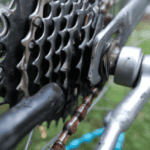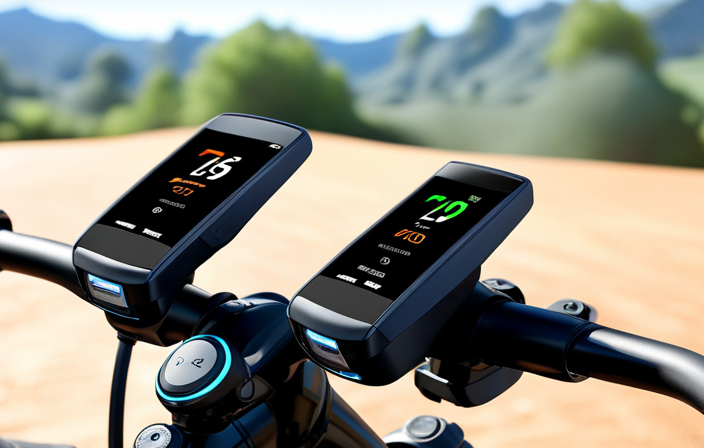Ever wondered how to remove the rear wheel of your electric bike? Well, as the saying goes, ‘knowledge is power.’
In this comprehensive guide, we will walk you through the step-by-step process of removing the rear wheel with ease and precision.
From gathering the necessary tools to inspecting for any damage, we’ve got you covered.
So, tighten your helmet and let’s dive into the world of electric bike maintenance.
Key Takeaways
- Find a suitable location and gather necessary tools
- Release the brakes and derailleur
- Loosen the nuts or quick-release lever
- Lift and remove the rear wheel, inspect, make repairs, and reinstall
Gather the necessary tools and equipment
You’ll need to gather the necessary tools and equipment for removing the rear wheel of your electric bike.
Bike maintenance is crucial for ensuring optimal performance and longevity of your bike.
Start by finding a suitable location for the task, ensuring proper bike storage and adequate space to work.
You’ll need a few tools, including a wrench or allen key that fits the axle nuts or bolts, and a tire lever to remove the tire from the rim if necessary.
Additionally, it’s recommended to have a work stand or a sturdy support to elevate the bike, making it easier to access the rear wheel.
Once you have all the tools and equipment ready, you can proceed to the next step of preparing the bike for wheel removal.
Prepare the bike for wheel removal
First, make sure you’re ready to take off the back tire. Bike maintenance and repair require some basic tools and equipment. You will need a wrench or a socket set to remove the nuts or bolts that hold the wheel in place. It’s also helpful to have a bike stand or a sturdy surface to support the bike while you work.
Start by flipping the bike upside down or placing it in a bike stand. Next, shift the gears to the smallest chainring and the smallest rear cog to release tension on the chain.
Loosen the nuts or bolts that hold the wheel in place using your wrench or socket set. Once the nuts or bolts are loose, you can proceed to the next step of releasing the brakes and derailleur.
Release the brakes and derailleur
To release the brakes and derailleur, simply squeeze the brake levers and shift the gears to the lowest setting. This will reposition the derailleur and allow for easier removal of the rear wheel. Before proceeding, it is important to note that the specific steps may vary depending on the make and model of your electric bike. Refer to your bike’s user manual for detailed instructions.
To adjust the brake tension, use the table below as a guide:
| Brake Type | Adjusting Method |
|---|---|
| Disc | Turn the barrel adjuster clockwise to increase tension or counterclockwise to decrease tension |
| Rim | Use an Allen wrench to adjust the brake pads closer to or further away from the rim |
Once the brakes and derailleur have been released and adjusted, you can proceed to the next step of loosening the nuts or quick-release lever. This will allow for easy removal of the rear wheel.
Loosen the nuts or quick-release lever
After releasing the brakes and derailleur, proceed to loosen the nuts or quick-release lever.
When removing the rear wheel of an electric bike, you have two options for the tools: a torque wrench or a regular wrench. If you have a torque wrench, set it to the recommended torque specification for your bike’s rear axle. If you don’t have a torque wrench, a regular wrench will suffice, but be careful not to overtighten or undertighten the nuts.
Start by placing the wrench on the nuts or quick-release lever and turning counterclockwise to loosen them. Once they are loose enough, you can use your hand to unscrew them completely. Remember to keep track of any washers or spacers that may come off with the nuts.
Now, you can smoothly transition into the next step of removing the chain from the rear gears.
Remove the chain from the rear gears
Now, you can proceed by taking the chain off the gears at the back.
To remove the chain from the rear gears of your electric bike, follow these steps:
- Start by shifting the chain onto the smallest rear gear to relieve tension.
- Use a chain breaker tool to break the chain at any link. This will allow you to separate the chain and remove it from the rear gears.
- Once the chain is disconnected, inspect it for any signs of wear or damage. If necessary, this is a good time to clean the chain using a degreaser and a brush.
After removing the chain from the rear gears, you are ready to carefully lift and remove the rear wheel.
This will allow you to perform any necessary maintenance or repairs on the wheel or tire.
Carefully lift and remove the rear wheel
First, you’ll need to carefully lift and detach the back wheel from your e-bike. Before you begin, make sure to take necessary safety precautions, such as wearing gloves and eye protection.
To lift the rear wheel, start by placing the bike on a stable surface. Then, locate the quick-release lever or axle nuts on either side of the wheel. If your e-bike has a quick-release lever, open it by flipping it up or turning it counterclockwise. If it has axle nuts, use a wrench to loosen them.
Once the wheel is loose, carefully lift it off the frame, making sure to support the weight of the wheel with your other hand.
Now, you can move on to inspecting the wheel and tire for any damage, ensuring a safe ride.
Inspect the wheel and tire for any damage
To check for any damage, carefully examine the wheel and tire of your e-bike. Start by inspecting the tire for any signs of wear, such as bald spots, cracks, or punctures.
Proper tire inflation is crucial for the performance and longevity of your electric bike, so ensure the tire is properly inflated according to the manufacturer’s recommendations. This will not only improve the ride quality but also prevent potential damage to the wheel and tire.
Additionally, choosing the right tire for your electric bike is essential. Consider factors such as tread pattern, durability, and grip to ensure optimal performance and safety.
Once you have inspected the wheel and tire and identified any damage or maintenance needs, you can proceed to make any necessary repairs or maintenance.
Make any necessary repairs or maintenance
You should address any necessary repairs or maintenance to ensure the proper functioning of your e-bike. When it comes to the rear wheel, there are a few common issues you might encounter.
Here are some tips for maintaining an electric bike:
- Inspect the spokes for any signs of damage or looseness.
- Check the tire pressure and tread wear for optimal performance.
- Examine the brake pads for wear and replace if necessary.
- Lubricate the chain and gears to reduce friction and extend their lifespan.
- Test the wheel alignment to ensure a smooth and straight ride.
By following these maintenance steps, you can prevent potential problems and keep your e-bike in top shape.
Now that you have addressed any necessary repairs or maintenance, you can proceed to reinstall the rear wheel onto the bike.
Reinstall the rear wheel onto the bike
After addressing any necessary repairs or maintenance, it is time to reinstall the rear wheel onto your bicycle. Follow these step-by-step instructions to ensure a proper reinstallation.
First, align the axle of the wheel with the dropouts on the frame. Slide the wheel into place, making sure it is centered between the chainstays. Tighten the quick release lever or axle nuts to secure the wheel.
Next, check the chain tension and adjust it if necessary. Ensure that the wheel spins freely and the brakes do not rub against the rim.
If you encounter any issues, such as the wheel not fitting properly or the brakes not functioning correctly, refer to the troubleshooting section in your bike’s manual.
Once the wheel is securely installed, you can then move on to testing the wheel and brakes before riding again.
Test the wheel and brakes before riding again
Before taking your bicycle out for a ride, make sure to test the wheel and brakes to ensure they are functioning properly. Follow these step-by-step instructions to perform a thorough test:
-
Check the brakes: Squeeze the brake levers firmly to see if they engage properly. The brake pads should make contact with the wheel rim or disc and provide adequate stopping power. If the brakes feel loose or weak, they may need adjustment or replacement.
-
Inspect the brake cables: Look for any fraying or damage in the brake cables. Make sure they are properly connected and not overly stretched. Replace any worn-out cables to ensure optimal brake performance.
-
Check tire pressure: Use a tire gauge to measure the pressure in each tire. Refer to the manufacturer’s recommended pressure range and adjust accordingly. Insufficient tire pressure can affect your bike’s handling and increase the risk of flats.
By following these steps, you can ensure that your bike’s wheel and brakes are in optimal working condition before setting off on your next ride.
Frequently Asked Questions
Do I need any special tools to remove the rear wheel of an electric bike?
To remove the rear wheel of an electric bike, you will need a few special tools. Follow this step-by-step guide to ensure a smooth process. First, gather the necessary tools, including a wrench and a tire lever.
Can I remove the rear wheel of an electric bike without releasing the brakes and derailleur?
Removing the rear wheel of an electric bike without releasing the brakes and derailleur can be challenging. It may require special tools and careful steps, such as removing the chain from the rear gears to avoid damage. After removing the wheel, inspect it for any damage and perform tests on the wheel and brakes for proper functioning.
Is it necessary to remove the chain from the rear gears before removing the rear wheel?
To ensure chain maintenance and proper wheel alignment, it is necessary to remove the chain from the rear gears before removing the rear wheel of an electric bike. Follow these step-by-step instructions for a successful removal process.
How can I inspect the wheel and tire for any damage?
To inspect the wheel and tire for damage, start by checking the tire pressure using a gauge. Then, ensure proper wheel alignment by spinning the wheel and looking for any wobbling or rubbing against the brakes or frame.
Are there any specific tests I should perform on the wheel and brakes after reinstalling the rear wheel?
To properly adjust the brakes after reinstalling the rear wheel, follow these steps: 1) Squeeze the brake lever to check for proper engagement. 2) If needed, adjust the brake cable tension. To fix wheel misalignment, 1) Loosen the axle nuts. 2) Center the wheel. 3) Retighten the nuts.
Conclusion
Congratulations! You’ve successfully mastered the art of removing the rear wheel of an electric bike. Now you can proudly call yourself a wheel removal expert.
Just remember, the key to a smooth removal process is having the right tools, taking your time, and being patient.
So next time you find yourself in need of some rear wheel removal action, don’t fret. You’ve got this!
Happy biking and may your wheels always spin flawlessly.
















